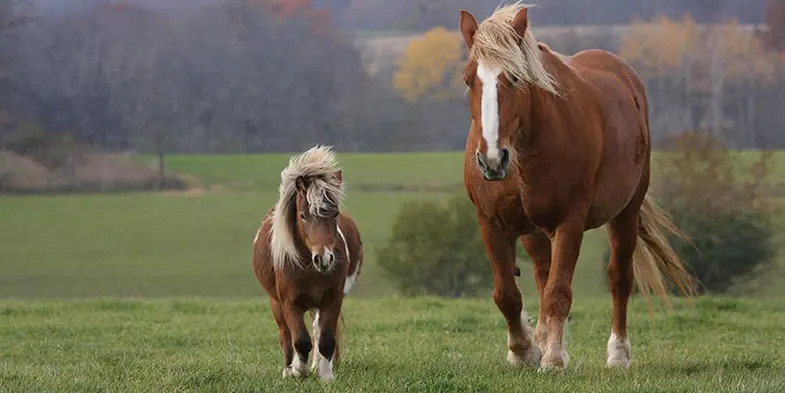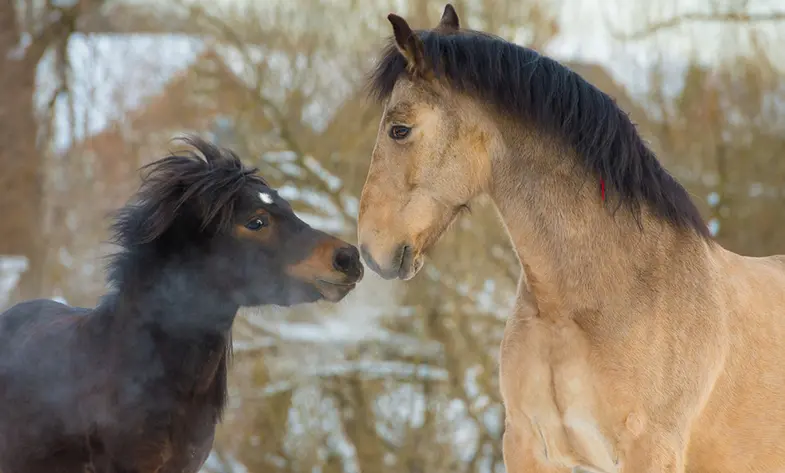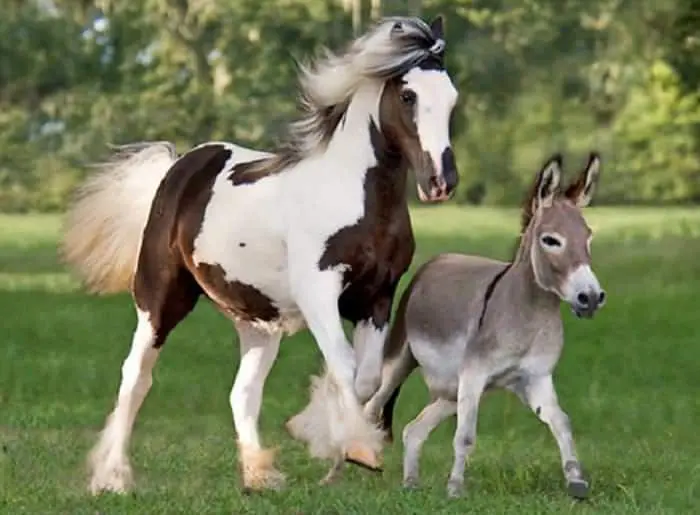With there being so many different names for horses it can be difficult to know if a pony is just another one of those names, if it’s a baby horse, or even whether or not a pony is totally different to a horse. After all not only are they both part of the same species (known as Equus ferus) but they’re even from the same branch of the family tree (Equus ferus caballus). While it’s easy to see why people think horses and ponies are the same there are some very clear differences between the two which is what I hope to explain in this article.
What’s the difference between a horse and a pony? The most noticeable difference between horses and ponies is their height, horses are taller than 14.2hh while ponies are always under 14.2hh. Ponies are also stockier and have thicker coats compared to horses. Other, less obvious differences include dietary needs, personalities, and even longevity.
| Horses | Ponies | |
|---|---|---|
| Height | 14.3hh and over | Under 14.2hh |
| Build | Refined body, lean legs, and long necks | Stocky, broad heads, round chests, and shorter legs |
| Coat & Hair | Fine, soft coat generally with shorter hair | Coarse, dense coat with thicker mane and tail |
| Temperament | Quiet, docile, and willing to work | Intelligent, determined, and good at avoiding work |
| Metabolism | Fast (hard keepers) | Slow (easy keepers) |
| Dietary Needs | Need high-quality food | Don’t need high-quality food |
| Retirement Age | Early to mid-20s | Late 20s |
| Lifespan | Up to 30 | 30+ |
Main differences between horses and ponies
While height is the primary (and most obvious) difference between a horse and a pony there are a number of other differences between the two, some of which are more noticeable than others.
Height of horses vs ponies
The most obvious difference between a horse and a pony is their height and while there will always be an exception to the rule it’s generally agreed that a pony can’t be taller than 14.2hh and that horses are taller than 14.2hh.
Overall build and appearance of horses vs ponies
Horses have a more refined build with longer, leaner legs, longer necks, and more elegant heads. Ponies, on the other hand, have thicker heads with broad foreheads. They also have shorter necks and more compact legs.
A horse’s coat tends to be thinner than that of a pony while a pony will have a thicker mane and tail too.
Temperament of horses vs ponies
Ponies are often said to be stubborn but this isn’t actually the case, instead, they’re highly intelligent and are reluctant to do something that they think is a waste of time. Horses, however, aren’t quite as intelligent and are more likely to get themselves into trouble. Horses are also generally to be more placid and generally more willing than ponies.
The cost of keeping horses vs ponies
You might think that horses and ponies cost roughly the same but there can often be a big difference in the cost of them both. Ponies are often cheaper than horses to buy but they also need less food and don’t have as many day-to-day costs.
Ponies tend to have thicker winter coats so don’t need to be blanketed as often as horses do. They also have tougher hooves so are less likely to need corrective footwear.
Maturity of horses vs ponies
Horses generally take slightly longer to develop than ponies, while ponies normally reach full maturity by the time they’re six years old, horses mature at around seven years of age.
Dietary needs of horses vs ponies
Most ponies are easy keepers which means they don’t have any trouble putting weight on or keeping the weight they already have. While this can mean they don’t need as much high-quality food it does also mean they’re prone to conditions such as laminitis or Equine Cushing’s Disease.
Horses, on the other hand, are more prone to being hard keepers which makes it harder for them to maintain their body weight. This can make them more expensive to keep because they’re not able to get as much nutrition from poor quality forage so need high-quality food.
Strength of horses vs ponies
You might be surprised to know that, despite their size, ponies are in fact stronger than horses, at least in relation to their size. It’s believed that their strong bones and stocky build help them to carry more weight than their bigger horse counterparts can manage.
General health of horses vs ponies
Both horses and ponies are at risk of the same illnesses and health conditions, but due to the tendency to put on weight ponies are more susceptible to conditions such as laminitis.
A recent study found that ponies have more leukocytes (cells that live in the blood and help to fight disease) so often heal much quicker than horses do [source].
Longevity of horses vs ponies
While many horses can live well into their thirties the average age for a horse is somewhere between 25 and 30 whereas most ponies can live long past their thirties. A lot of ponies will also continue working into their later 20s while most horses are retired before the age of 25.
What are the similarities between horses and ponies?
We’ve talked a lot about the differences between horses and ponies but to really understand what’s different between them it’s helpful to know what similarities they share. Being from the same family they obviously look pretty similar, albeit with an often noticeable height difference but they actually have a lot more in common than just appearances.
Yes, ponies are known for being more stubborn but both horses and ponies have gentle, willing natures that make them easy to train.
They also have the same digestive system that means while ponies have a tendency to be more greedy both horses and ponies can eat the same things but also can suffer from the same conditions such as colic.
Is a horse or pony better for me?
Buying a horse or pony is a big decision and an even bigger commitment so it’s important to make sure you’re buying what’s right for you.
You might feel that you can’t own a horse until you’ve owned a pony first but this is very rarely the case. While ponies will probably be suitable first mounts for many children (and some adults) it doesn’t mean that you should always have a pony first.
What are you familiar with?
If you’re an experienced rider then what are you used to riding? This might not seem relevant but if you’re used to riding ponies you might feel overwhelmed riding a full-sized horse. Likewise, if you normally ride a big horse you may well feel uncomfortable riding a pony.
What size horse or pony is best for you?
You might think that the bigger the horse the more weight they can carry, but this isn’t quite true. While larger riders do tend to be better suited to bigger horses it’s actually the horse’s weight that determines how much weight they can carry.
As a rough guide, small children are often better suited to ponies with teenagers being just as well suited to horses and ponies. Adults, on the other hand, are usually better off with horses.
If you’re not sure what size horse you should be riding then check out my recent article explaining how to find the right horse for your weight and height.
What do you plan to do with your new horse or pony?
This probably doesn’t seem very relevant and in many cases, it isn’t but there are some disciplines where the size of your mount does make a difference. For example, if you’re planning to do a lot of jumping then a bigger horse will be able to clear the fences that many ponies will struggle with. Conversely, if you enjoy gymkhana events then a pony will have a lower center of gravity so will therefore be more nimble.
As a footnote, it’s worth mentioning that I once let a friend’s daughter borrow my Quarter Horse, Milo, for a Pony Club event, the problem was that he was just too fast for her. In the end, my friend bought her daughter a POA who turned out to be perfect, she was still fast but not in an uncontrollable way.
Are pony sized horses still horses?
When asked what the difference between a horse and a pony is, most people will say it’s their size but while this is generally true it’s not always the case. Some horse breeds (such as the Icelandic Horse or the Gypsy Vanner) are smaller than the ‘normal’ 14.2hh lower limit for horses but are still considered to be horses rather than ponies.
In these cases, their build and more importantly bone structure are taken into account when deciding whether they’re indeed horses or ponies.
Related questions
Are horses and ponies the same as donkeys?
While horses and ponies are from the same Equus family they are in fact two separate species. Horses and ponies are from the Equus ferus caballus family while donkeys are from the Equus Africanus Asinus branch. This means that, while they may look physically similar they’re genetically very different with horses and ponies having 32 chromosomes and donkeys having only 31.
What’s the difference between a pony and a Miniature Horse?
While a Miniature Horse is certainly a lot smaller (standing at no more than 8.5hh (34 inches)) than the 14.2hh threshold for most ponies it is still a horse rather than a pony. This is because of the structure and proportions of their bones, rather than having the sturdy build you’d expect from a pony they have the same lean build associated with a horse. This means that it’s not as strong as a pony so it can’t carry as much weight and therefore can only be ridden by a child weighing less than 5 stone (70lbs), although they are often used for driving.
Can horses mate with ponies?
You might be surprised to know that not only can horses and ponies mate but it’s not as rare as you might think. Unlike horses and donkeys which are different species, horses and ponies are from the same family so the resulting offspring inherit the characteristics of both parents. That’s not to say though that it’s always a good idea for the two to breed and if you are thinking of doing so then there are a few things that you need to take into account first.
If the stallion is a pony then there are less likely to be complications for the mare but if the stallion is a horse then it’s important to take their different heights into consideration. Ponies haven’t evolved to be able to give birth to horse-sized foals which can cause problems during birth if the foal is too big.
In order to reduce the risk of producing a foal that the mare could have problems giving birth to it’s better to use a male pony and female horse. This is more likely to result in a foal that isn’t as big, but studies have shown that if the height difference is too great then this can also cause birthing complications, albeit a lower risk.
If you do want to mate a pony with or horse or vice versa then it’s important to speak to a vet beforehand. He will be able to help advise you of the best way of doing this for the results you’re after.
I hope you found this article helpful. If you did I’d be grateful if you could share it please as it would really help me.
Recommended products
Over the years I have tried hundreds of different horsey products, from various blankets and halters to different treats. Some I’ve loved, others I’ve hated but I thought I’d share with you my top all-time favorite products, the ones I never leave the yard without. I’ve included links to the products (which are in no particular order) that I really think are great.
- Horse Knots by Reference Ready – If you’re like me and enjoy pocket reference guides then you’ll love this knot tying guide. These handy cards can easily fit in your pocket or attach to the saddle for quick reference. They’re waterproof, durable and are color coded to make them easy to follow.
- Mane ’n Tail Detangler – Even if you never show your horse you’ll need to detangle his tail from time to time (and possibly his mane too) which is always a challenging chore! I’ve found that if I run a little bit of detangler through my horse’s tails every few days it stops them from getting matted up and makes combing them easy, even if they’re coated in mud. I don’t know if I should admit to this or not but it also works wonders on my hair.
- TAKEKIT Pro clippers – Over the years I’ve tried a lot of different clippers and while some were obviously better than others I found these to be by far the best. They are heavier than a lot of other clippers but for me, that’s a good thing, it makes them feel more sturdy and hardwearing. On top of that they have a range of speeds so are just as good for clipping your horse’s back as they are his face. I also like the fact that they come in a handy carry case but that’s not for everybody. The company that makes them is super good and incredibly helpful too, a real bonus these days. The only thing I wasn’t keen on was the fact that it doesn’t come with any oil, but that’s not a major problem as it’s not difficult to buy lubricant.
- Shire’s ball feeder – There are so many boredom buster toys out there but I like to use these every day, regardless of whether or not my horses are bored. I find that it helps to encourage my horses to problem solve by rewarding them with treats (or pieces of fruit) but it also mimics their natural grazing behavior which helps to keep them calm and de-stressed.
- Horse safe mirror – This is a strange one that many people are surprised about but I like to put horse safe mirrors in the trailers as well as in the quarantine stalls. It helps to prevent the feeling of isolation by giving the impression of other horses being around. Being herd animals horses can get extremely stressed when they feel that they’re on their own but with these stick-on mirrors, they believe that at least one other horse is with them.
- Rectal thermometer – I know this isn’t glamourous at all but it’s vital for your horse’s well-being to be able to check their temperature and a rectal thermometer is the easiest way of doing this which is why I’ve added it to the list.
Shopping lists
I’ve also put together a few shopping lists of essential items that I’ve found helpful over the years. I’ve broken the lists down into different categories rather than put everything in one massive list 😉



